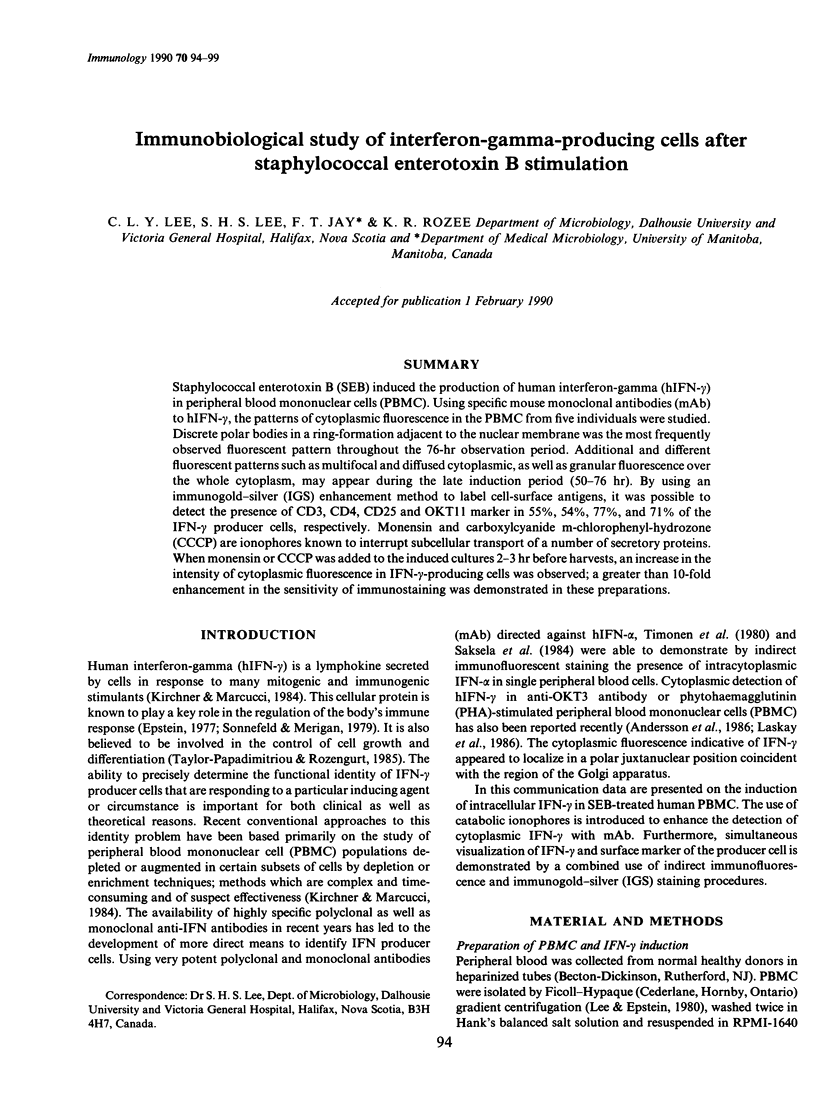Immunobiological study of interferon-gamma-producing cells after staphylococcal enterotoxin B stimulation (original) (raw)
Abstract
Staphylococcal enterotoxin B (SEB) induced the production of human interferon-gamma (hIFN-gamma) in peripheral blood mononuclear cells (PBMC). Using specific mouse monoclonal antibodies (mAb) to hIFN-gamma, the patterns of cytoplasmic fluorescence in the PBMC from five individuals were studied. Discrete polar bodies in a ring-formation adjacent to the nuclear membrane was the most frequently observed fluorescent pattern throughout the 76-hr observation period. Additional and different fluorescent patterns such as multifocal and diffused cytoplasmic, as well as granular fluorescence over the whole cytoplasm, may appear during the late induction period (50-76 hr). By using an immunogold-silver (IGS) enhancement method to label cell-surface antigens, it was possible to detect the presence of CD3, CD4, CD25 and OKT11 marker in 55%, 54%, 77%, and 71% of the IFN-gamma producer cells, respectively. Monensin and carboxylcyanide m-chlorophenyl-hydrozone (CCCP) are ionophores known to interrupt subcellular transport of a number of secretory proteins. When monensin or CCCP was added to the induced cultures 2-3 hr before harvests, an increase in the intensity of cytoplasmic fluorescence in IFN-gamma-producing cells was observed; a greater than 10-fold enhancement in the sensitivity of immunostaining was demonstrated in these preparations.

Images in this article
Selected References
These references are in PubMed. This may not be the complete list of references from this article.
- Alfa M. J., Dembinski J. J., Jay F. T. Production of monoclonal antibodies against recombinant human interferon-gamma: screening of hybridomas without purified antigen. Hybridoma. 1987 Oct;6(5):509–520. doi: 10.1089/hyb.1987.6.509. [DOI] [PubMed] [Google Scholar]
- Andersson U., Laskay T., Andersson J., Kiessling R., DeLey M. Phenotypic characterization of individual interferon-gamma-producing cells after OKT3 antibody activation. Eur J Immunol. 1986 Nov;16(11):1457–1460. doi: 10.1002/eji.1830161124. [DOI] [PubMed] [Google Scholar]
- Jay E., Rommens J., Pomeroy-Cloney L., MacKnight D., Lutze-Wallace C., Wishart P., Harrison D., Lui W. Y., Asundi V., Dawood M. High-level expression of a chemically synthesized gene for human interferon-gamma using a prokaryotic expression vector. Proc Natl Acad Sci U S A. 1984 Apr;81(8):2290–2294. doi: 10.1073/pnas.81.8.2290. [DOI] [PMC free article] [PubMed] [Google Scholar]
- Laskay T., Andersson U., Andersson J., Kiessling R., DeLey M. An immunofluorescent method for identifying individual IFN-gamma-producing lymphocytes. J Immunol Methods. 1986 Dec 4;95(1):1–7. doi: 10.1016/0022-1759(86)90310-8. [DOI] [PubMed] [Google Scholar]
- Lee S. H., Epstein L. B. Reversible inhibition by interferon of the maturation of human peripheral blood monocytes to macrophages. Cell Immunol. 1980 Mar 1;50(1):177–190. doi: 10.1016/0008-8749(80)90016-7. [DOI] [PubMed] [Google Scholar]
- Saksela E., Virtanen I., Hovi T., Secher D. S., Cantell K. Monocyte is the main producer of human leukocyte alpha interferons following Sendai virus induction. Prog Med Virol. 1984;30:78–86. [PubMed] [Google Scholar]
- Sonnenfeld G., Merigan T. C. A regulatory role for interferon in immunity. Ann N Y Acad Sci. 1979;332:345–355. doi: 10.1111/j.1749-6632.1979.tb47128.x. [DOI] [PubMed] [Google Scholar]
- Tartakoff A., Vassalli P., Détraz M. Comparative studies of intracellular transport of secretory proteins. J Cell Biol. 1978 Dec;79(3):694–707. doi: 10.1083/jcb.79.3.694. [DOI] [PMC free article] [PubMed] [Google Scholar]